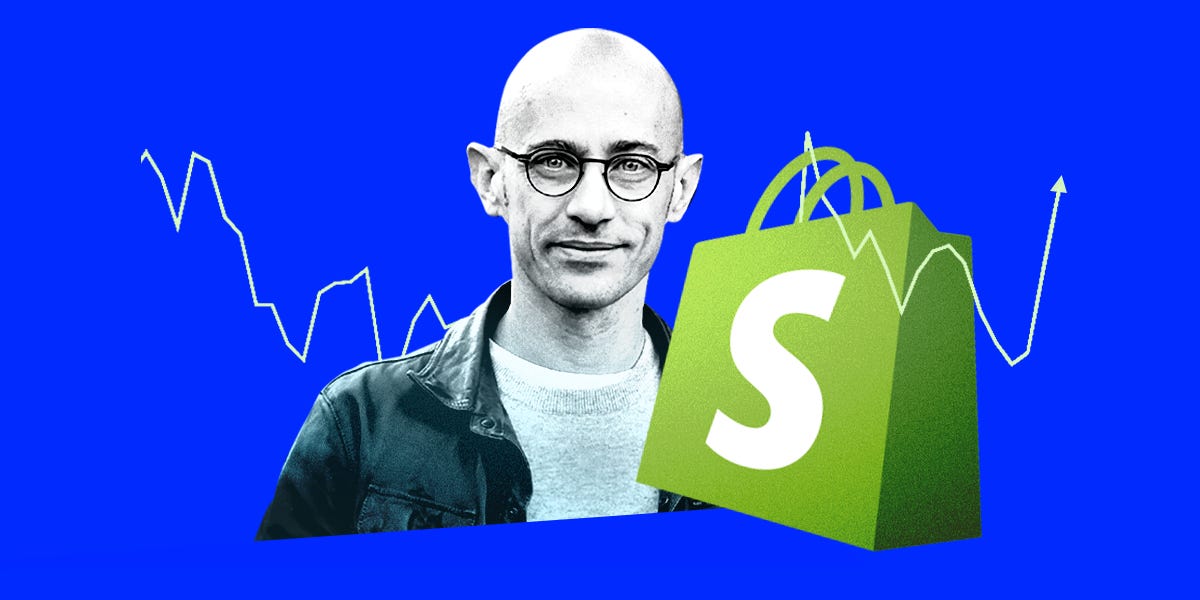In October 2022, Shopify’s once high-flying stock hit its lowest price since before the Covid pandemic.
Less than a year prior, shares in the Canadian e-commerce company had hit all-time highs, reaching $168 in November 2021 amid pandemic-fueled revenue and sales growth.
A few months later, in June 2022, Shopify completed a 10-for-1 stock split for more investors to buy in, but by then, the landscape had changed, and investors had a lot of questions for Shopify. It turned out that the Covid bump to e-commerce was not as permanent as people had predicted. The tech sector took a downturn as interest rates quickly rose.
Shopify had made an expensive acquisition in its $2 billion purchase of fulfillment startup Deliverr, and investors were wondering whether the investment in logistics would pay off. The company lost about $118 billion in market value in 2022.
Now, after two rounds of layoffs and a divestment of its fulfillment and logistics business, the picture looks a bit different for Shopify. Since August 2023, company leaders have been talking about the “new shape of Shopify,” and its revamped vision seems to have paid off, with the stock rising about 200% since its low in 2022.
Analysts told Business Insider that Shopify essentially did a “complete 180.” They’re now feeling more optimistic about the company’s prospects thanks to the well-timed head count reductions, logistics exit, and rediscovered profitability.
Shopify has now set its sights on enterprise retail, growing its sales force to win over customers from legacy providers, improving its point-of-sale offering, and expanding its international capabilities.
Shedding a “money-losing logistics business”
Dropping logistics and fulfillment is a major part of Shopify’s stock comeback story.
The company’s logistics journey began in 2019 when it acquired warehouse robotics startup 6 River Systems for $450 million and embarked on a plan to build an “asset-light” fulfillment network that largely relied on third-party partnerships. The goal was to provide Shopify’s merchants with an alternative to Amazon’s fulfillment services.
However, in early 2022, the company began moving away from that asset-light model and said it planned to invest $2 billion through 2024 to build out a fulfillment network on its own. The plan took many “sharp turns” along the way. By the time Shopify acquired Deliverr in the spring of 2022, investors had grown impatient.
With interest rates rising, “most tech vendors were pulling back on investment, so Shopify was going against the grain, and it wasn’t necessarily proving to be effective,” Oppenheimer analyst Ken Wong said.
In May 2023, Shopify announced it would be selling the logistics business entirely to Flexport. Investors welcomed that decision, and the stock rose accordingly. While it started 2023 with negative margins, it was profitable again by the end of the year.
By making those changes, the company “instantly pivoted from growth at all costs to profitable growth,” Wong said.
“Handing off the money-losing logistics business helped very much,” D.A. Davidson analyst Gil Luria said.
The divestment also provided the company with a clearer road map. In a blog post announcing the news, CEO Tobi Lütke described its abandoned logistics effort as a “side quest” that distracted Shopify from its “main quest” of building software for merchants.
Since then, Shopify has largely doubled down on its main quest by focusing on improving its software offerings, including by incorporating AI throughout its operations.
Shopify’s well-timed pivots
Shopify made two major cuts to its head count in 2022 and 2023, after its post-pandemic slump.
The company pledged to make 2,021 technical hires in 2021, and by the end of that year, it had more than 10,000 employees, according to the company’s annual filing with the SEC. At the end of 2022, it had over 11,600.
In July 2022, Lütke announced in a memo that the company would be laying off 10% of staff, or more than 1,000 employees. The layoffs were necessary, Lütke said, because Shopify had made a bet on e-commerce continuing on an upward trajectory that didn’t ultimately pan out.
In May 2023, Shopify cut another 20% of its workforce as it sold its logistics business to Flexport.
Analysts said the market responded favorably to Shopify’s layoffs because they were well-timed and came along with a significant change in focus.
“Instead of dragging it out and reacting to the market, they proactively went out and changed their business to fit the reality that they were in and really made a big cultural change in terms of staffing level and discipline around investing,” Luria said.
Shopify also replaced much of its management team post-pandemic, with perhaps the most notable hire being former Morgan Stanley investment banker Jeff Hoffmeister as CFO in October 2022.
Shopify’s stock has also responded favorably when the company has raised prices for its software, which it has done twice in the last year. It first announced in January 2023 that it would be raising prices for its base subscription plan, by 33% for monthly plans and 12% for annual plans. Then, this February, it told merchants that prices would be going up for its more expensive Plus plans unless merchants opted into a three-year contract.
Merchants have stayed put since the price hikes.
“With the lack of churn after the price increase, you did see how valuable this software is to a merchant in terms of their overall health,” Deutsche Bank analyst Bhavin Shah said. “It highlighted the stickiness of the platform and how differentiated they could be versus some of the peers.”
Setting its sights on larger customers
Shopify has made a significantly bigger push into enterprise retail. It has hired at least two dozen people from Salesforce, including several senior sales leaders, as it looks to win over larger merchants. That team has had to take a different approach to customer acquisition than Shopify has used in the past, as selling to enterprise retailers tends to take more time and effort than Shopify’s typical small and midsize business customers.
It has also added more technical features that would appeal to larger merchants, like increasing the number of product variants sellers can display on a page, or allowing retailers to incorporate select parts of its technology without making a full-scale migration onto the platform.
Having larger retailers use Shopify would ultimately lead to a higher volume of sales through the platform — a measure that Shopify refers to as gross merchandise volume, or GMV. The company’s GMV grew 20% to $235.9 billion in 2023.
“We’ve seen, over the last year or so, the amount of enterprises that are looking to move on to Shopify and maybe away from some of the competing vendors has definitely upticked, which is helping drive a lot of that GMV growth,” Shah said.
Making it easier for merchants to expand internationally and improving its B2B offerings are also priorities for the company, Luria said.
“Between all those different expansions, Shopify is expanding its growth rate beyond the underlying growth of e-commerce,” he added.
Got a tip? Contact this reporter at mstone@businessinsider.com, mlstone@protonmail.com, or on the secure messaging app Signal at (646) 889-2143 using a non-work phone.




